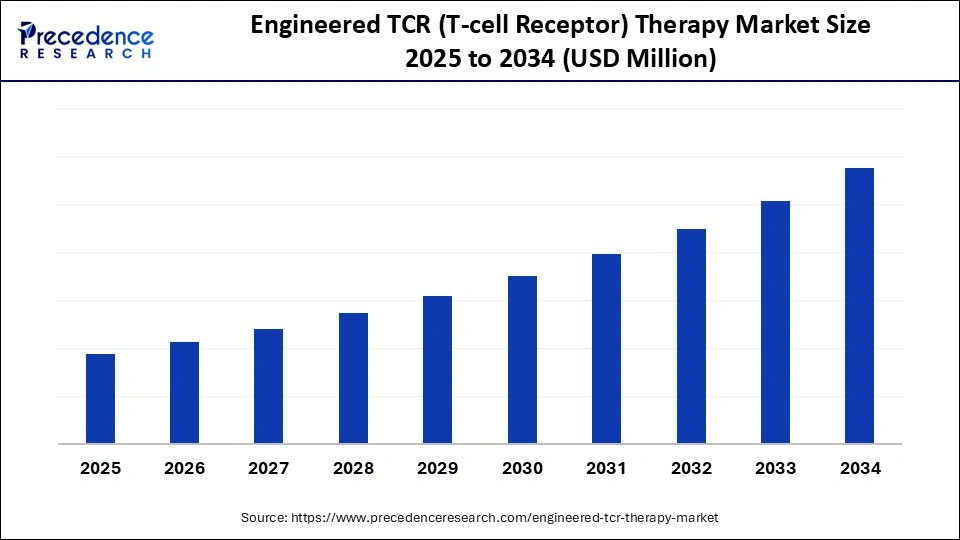Revolutionizing cancer treatment with targeted immunotherapy, the engineered TCR therapy market is forecast to grow rapidly at a robust CAGR driven by technological innovations and expanded clinical applications.
The global engineered TCR (T-cell receptor) therapy market is rapidly advancing, riding a wave of increasing cancer incidence, especially solid tumors, and breakthroughs in immunotherapy. Expected to grow significantly from 2025 to 2034, the market growth is supported by cutting-edge gene editing, neoantigen targeting, and successful clinical trial outcomes.
With a swift Compound Annual Growth Rate (CAGR) indicative of its market potential, engineered TCR therapy offers hope by accessing intracellular tumor antigens unreachable by traditional CAR-T therapies, making it a game-changer in oncology and viral infection treatments.

Engineered TCR Therapy Market Key Insights
-
The market is dominated by North America, holding approximately 45% share as of 2024.
-
Asia Pacific is the fastest-growing region, driven by biotech startups and increased healthcare investment.
-
The affinity-enhanced TCR therapy segment leads with a 50% market share, favored for its efficacy in both hematologic and solid tumors.
-
Viral vector-based delivery accounts for 60% of the market due to its established clinical reliability.
-
Solid tumor treatment dominates with around 68% share, given the high unmet medical need.
-
Pharmaceutical companies account for 55% of the market, due to their advanced infrastructure and regulatory capabilities.
Get this report to explore global market size, share, CAGR, and trends, featuring detailed segmental analysis and an insightful competitive landscape overview @ https://www.precedenceresearch.com/sample/6967
Market Segments
| Segment | Notable Details |
|---|---|
| Therapy Type / TCR Design | Affinity-enhanced dominates; gene-edited/non-viral fastest-growing. |
| Delivery Method | Viral vector-based leads; non-viral/CRISPR fastest growth. |
| Indication / Cancer Type | Solid tumors dominate; infectious diseases fastest growing. |
| End-User | Pharmaceutical companies lead; CDMOs fastest expanding. |
| Regions | North America leads; Asia Pacific fastest growth. |
Artificial Intelligence is playing an increasingly pivotal role in engineered TCR therapy development. By leveraging AI’s capacity for large-scale data analysis and pattern recognition, researchers can accelerate the identification of optimal TCR sequences and neoantigens, enabling highly personalized and precise immunotherapies. AI-driven computational models also streamline clinical trial designs and predict patient responses, reducing time and cost.
Moreover, AI enables enhanced manufacturing process control by optimizing gene editing and T-cell cultivation stages, ensuring more consistent quality and scalability in therapies. Together, these AI applications not only improve therapy efficacy but also address manufacturing challenges that have historically constrained the market.
Engineered TCR (T-Cell Receptor) Therapy Market Growth Factors
Several key factors are propelling market expansion:
-
Rising global cancer rates with a shift towards solid tumor therapies.
-
Positive clinical trial outcomes enhancing regulatory approvals and adoption.
-
Advancements in gene editing technologies, including CRISPR, facilitating gene-modified TCRs.
-
Growing investments from pharmaceutical firms and government bodies.
-
Emergence of off-the-shelf allogeneic therapies promising rapid treatment delivery and reduced costs.
Engineered TCR (T-Cell Receptor) Therapy Market Opportunities and Trends
What drives the high market share of affinity-enhanced TCR therapies?
Affinity-enhanced TCR therapies exhibit improved tumor antigen specificity and stronger binding properties, making them effective in overcoming natural TCR limitations. This enhanced efficacy attracts significant clinical adoption and late-stage trial support.
How are delivery methods evolving in this market?
While viral vector-based delivery remains dominant due to regulatory familiarity and robust gene transfer, non-viral and CRISPR-based delivery methods are accelerating, as they reduce risks, improve precision, and support scalable off-the-shelf therapies.
Which regions offer the best growth prospects?
North America leads with superior infrastructure and funding, but the Asia Pacific region is the fastest-growing due to rising healthcare investments and expanding clinical trials.
Engineered TCR (T-Cell Receptor) Therapy Market Regional and Segmentation Insights
North America dominates, encompassing major pharmaceutical hubs, stringent regulatory frameworks, and vast clinical networks that foster innovation. Europe follows with growing research collaboration, while Asia Pacific’s biotech surge and government support propel rapid growth across China, India, and emerging markets.
Segmentation analysis reveals affinity-enhanced TCR therapies as the top therapy type, viral vector-based as the leading delivery approach, and solid tumors accounting for the majority indication share, reflecting unmet medical needs. Pharmaceutical companies are primary market drivers, though Contract Development and Manufacturing Organizations (CDMOs) are rapidly expanding to support smaller biotechs.
Companies in the Engineered TCR (T-Cell Receptor) Therapy Market
- Lion TCR Pte Ltd.
- TCRCure Biopharma Corp.
- Asher Biotherapeutics Inc.
- Be Biopharma Inc.
- China Immunotech Inc.
Challenges and Cost Pressures
The complexity of gene editing, strict Good Manufacturing Practice (GMP) standards, and labor-intensive cell extraction processes contribute to high therapy costs and production bottlenecks. Standardization and automation remain emergent, hindering mass-market scalability. Balancing safety, efficacy, and economic production continues to challenge developers and policymakers.
Case Study: Streamlining Off-the-Shelf TCR Therapies
A leading biotech implemented CRISPR-based gene editing to develop an off-the-shelf TCR therapy targeting melanoma, resulting in a 30% reduction in manufacturing time and significant cost savings compared to traditional autologous methods. Early clinical data demonstrate promising efficacy with an improved patient treatment turnaround, exemplifying the potential for next-gen therapies to overcome current market barriers.
Read Also: Molecular Computing Market
You can place an order or ask any questions. Please feel free to contact us at sales@precedenceresearch.com |+1 804 441 9344
- Robotic Arm Market Size to Touch USD 555.44 Billion by 2034 - October 13, 2025
- In Vivo Cell Reprogramming Market to Reach Significant Valuation by 2034 with Rapid Growth Driven by Regenerative Medicine Innovations - October 13, 2025
- Air Freight Forwarding System Market Size to Soar to USD 13.61 Billion by 2034 with 4.33% CAGR Growth Forecast - October 13, 2025
